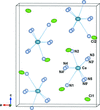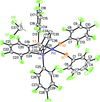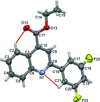issue contents
May 2016 issue

Cover illustration: The polymeric compound, [PbBr2(C10H8N2)]n, consists of 1![[infinity]](/logos/entities/infin_rmgif.gif) [PbBr4/2] chains running parallel to [001]. Each PbII atom is additionally chelated by a 2,2'-bipyridine ligand, completing a distorted octahedral Br4N2 coordination set. In the crystal, weak C-H
[PbBr4/2] chains running parallel to [001]. Each PbII atom is additionally chelated by a 2,2'-bipyridine ligand, completing a distorted octahedral Br4N2 coordination set. In the crystal, weak C-H Br hydrogen bonds and
Br hydrogen bonds and ![[pi]](/logos/entities/pi_rmgif.gif) -
-![[pi]](/logos/entities/pi_rmgif.gif) stacking interactions link the [PbBr2(C10H8N2)]n chains into a three-dimensional supramolecular structure. See: Zhang & Wu [IUCrData (2016). 1, x160782].
stacking interactions link the [PbBr2(C10H8N2)]n chains into a three-dimensional supramolecular structure. See: Zhang & Wu [IUCrData (2016). 1, x160782].
inorganic compounds
Download citation


Download citation


Open  access
access
 access
accessThe crystal structure of calcium octaammine dichloride has been redetermined based on synchrotron powder X-ray diffraction data, leading to more reasonable N⋯N distances.
CCDC reference: 1481351
metal-organic compounds
Download citation


Download citation


Open  access
access
 access
accessA lithium cation is coordinated by 2,6-bis(trialkylsilylamino)pyridine and diethyl ether and forms a centrosymmetric dimer.
CCDC reference: 1476698
Download citation


Download citation


Open  access
access
 access
accessIn the solvated title complex, the metal atom is coordinated by two cis thiolate ligands and one chelating P/S ligand.
CCDC reference: 1476213
Download citation


Download citation


Open  access
access
 access
accessA C4S2 donor set from bridging diethyl sulfide and biphenyl-2,2′-diyl ligands defines a distorted square-planar geometry about the PtII atoms in a binuclear Pt2unit, with very small deviations from planarity.
CCDC reference: 1479776
Download citation


Download citation


Open  access
access
 access
accessThe title compound is polymeric, with PbII atoms bridged by bromide ligands into chains extending parallel to [001].
CCDC reference: 1479535
Download citation


Download citation


Open  access
access
 access
accessIn the MnII cation adopts a distorted octahedral geometry. The crystal structure is stabilized by O—H⋯O, O—H⋯Br and C—H⋯O hydrogen bonds and π–π stacking interactions.
CCDC reference: 1481227
organic compounds
Download citation


Download citation


Open  access
access
 access
accessIn the title molecule, the central tricyclic moiety is twisted slightly, as indicated by the dihedral angles of 4.86 (5) and 0.97 (6)°, respectively, between the five-membered ring and the C3N3 and pyridyl rings.
CCDC reference: 1476505
Download citation


Download citation


Open  access
access
 access
accessIn the title molecular salt, the benzimidazole ring of the cation is protonated at its N atom and the L-aspartate zwitterion anion is deprotonated at an O atom. In the crystal, the anions are linked via three N—H⋯O hydrogen bonds involving the NH3+ group, forming layers parallel to the ab plane. The benzimidazolium cations are linked to these layers by N—H⋯O hydrogen bonds. The layers are linked via C—H⋯O hydrogen bonds, forming a three-dimensional structure. There are also C—H⋯π interactions present involving inversion-related benzimidazolium cations.
CCDC reference: 1475811
Download citation


Download citation


Open  access
access
 access
accessThe molecular and crystal structure of diethyl 2,6-dimethyl-4-(naphthalen-1-yl)-1,4-dihydropyridine-3,5-dicarboxylate is reported.
CCDC reference: 1477134
Download citation


Download citation


Open  access
access
 access
accessIn the structure of 2,6-dichloro-1H-indole-2,3-dione, N—H⋯O hydrogen bonds link the molecules into [100] chains.
CCDC reference: 1476205
Download citation


Download citation


Open  access
access
 access
accessThe structure of the title oxamide complex is reported. The crystal structure is stabilized by classical O—H⋯O and N—H⋯O hydrogen bonds.
CCDC reference: 1446193
Download citation


Download citation


Open  access
access
 access
accessIn the title compound, the indole and central pyrrole rings are inclined to one another by 13.15 (15)°. In the crystal, molecules are linked by pairs of N—H⋯N hydrogen bonds, forming inversion dimers with  (16) loops.
(16) loops.
CCDC reference: 1477342
Download citation


Download citation


Open  access
access
 access
accessThe asymmetric unit contains two independent molecules, slightly inclined to each other. In the crystal, molecules are interconnected by hydrogen bonds and C—H⋯π interactions.
CCDC reference: 1477135
Download citation


Download citation


Open  access
access
 access
accessThe title compound crystallized with three independent molecules in the asymmetric unit. In the crystal, a number of hydrogen bonds link the molecules to form layers, parallel to the ab plane, that enclose  (8) and
(8) and  (22) ring motifs.
(22) ring motifs.
CCDC reference: 1477449
Download citation


Download citation


Open  access
access
 access
accessIn the molecule, the anthraquinone ring system is slightly bent. The sole hydrogen-bond donor is bifurcated; in the molecule an intramolecular O—H⋯O hydrogen bond encloses an S(6) ring motif while in the crystal, pairs of O—H⋯O hydrogen bonds connect molecules into centrosymmetric dimers with an  (12) ring motif.
(12) ring motif.
CCDC reference: 1478251
Download citation


Download citation


Open  access
access
 access
accessHydrogen-bonded sheets occur in the crystal of the title hydrazone hydrate.
CCDC reference: 1478220
Download citation


Download citation


Open  access
access
 access
accessIn the title molecular salt, the pyridine ring of the cation is protonated at its N atom and the anion is deprotonated at an O atom. In the crystal, the ions are linked via three N—H⋯O hydrogen bonds into tetramers.
CCDC reference: 1478169
Download citation


Download citation


Open  access
access
 access
accessIn the crystal of the title compound, pairwise C—H⋯O hydrogen bonds form dimers which stack along the b-axis direction.
CCDC reference: 1478623
Download citation


Download citation


Open  access
access
 access
accessThe imidazopyridine moiety shows an r.m.s. deviation from planarity of 0.006 (19) Å. The dihedral angle between this plane and that of the 4-chlorophenyl group is 29.32 (8)°.
CCDC reference: 1478609
Download citation


Download citation


Open  access
access
 access
accessIn the crystal, C—H⋯N hydrogen bonds link the molecules into inversion dimers. The dimers are linked into columns along the b-axis direction via weak C—H⋯N contacts.
CCDC reference: 1478844
Download citation


Download citation


Open  access
access
 access
accessThe title compound is planar, with an r.m.s. deviation of 0.021 Å for all the non-H atoms. In the crystal, molecules are linked via a pair of C—H⋯O hydrogen bonds forming inversion dimers with an  (6) ring motif.
(6) ring motif.
CCDC reference: 1442202
Download citation


Download citation


Open  access
access
 access
accessThe title 1-H-pyrazole-3-carbohydrazide molecule shows a slight twist from end to end. The packing features N—H⋯N and bifurcated N—H⋯(N,O) hydrogen bonds, which generate (010) sheets.
CCDC reference: 1479830
Download citation


Download citation


Open  access
access
 access
accessIn the title compound, the dihedral angle between the chromene ring system and benzene ring is 19.19 (6)° and an intramolecular N—H⋯N hydrogen bond closes an S(6) ring. In the crystal, molecules are linked into [100] C(6) chains by N—H⋯O hydrogen bonds.
CCDC reference: 1478497
Download citation


Download citation


Open  access
access
 access
accessThe molecular and crystal structure of a second triclinic polymorph of ethyl 2-(3,5-difluorophenyl)quinoline-4-carboxylate is reported. The crystal structure is stabilized by C–H⋯O hydrogen bonds together with C—F⋯π and π–π interactions.
CCDC reference: 1477839
Download citation


Download citation


Open  access
access
 access
accessBoth molecules in the asymmetric unit of 5-bromo-2-methyl-1H-imidazo[4,5-b]pyridine lie on a crystallographic mirror plane.
CCDC reference: 1478650
Download citation


Download citation


Open  access
access
 access
accessThe crystal structure of an orthorhombic polymorph of D-(-)-2-azaniumyl-2-(4-hydroxyphenyl)acetate is reported. The crystal structure features N—H⋯O, O—H⋯O and C—H⋯π hydrogen bonds.
CCDC reference: 1478148
Download citation


Download citation


Open  access
access
 access
accessIn the title compound, C13H13NO, the pyrrole ring has a methyl group at the 3- and 5-positions. Classical N—H⋯O hydrogen bonds generate a one-dimensional structure.
CCDC reference: 1479616
Download citation


Download citation


Open  access
access
 access
accessIn the title compound, the indoline ring system, the ketonic atoms and the Br atom are nearly coplanar (r.m.s. deviation = 0.029 Å), and the nonyl side chain has an extended conformation. In the crystal, molecules are linked by C—H⋯O hydrogen bonds forming slabs parallel to (010).
CCDC reference: 1479813
Download citation


Download citation


Open  access
access
 access
accessIn the zwitterionic title compound, the piperidinium N atom is protonated and the OH group of one of the carboxylate groups is deprotonated. The crystal structure is stabilized by O—H⋯O, N—H⋯O and C—H⋯O hydrogen bonds.
CCDC reference: 1478206
Download citation


Download citation


Open  access
access
 access
accessIn the title compound, the spiropyrrolidine ring adopts a twisted conformation on the Cspiro—N bond, whereas the tetrahydropyran ring adopts a sofa confirmation. The pyrrolidine and tetrahydropyran rings are normal to one another with a dihedral angle of 89.1 (2)° between their mean planes.
CCDC reference: 1478907
Download citation


Download citation


Open  access
access
 access
accessIn the crystal structure of the title compound, the pyridine rings make a dihedral angle of 84.44 (5)°.
CCDC reference: 1480520
Download citation


Download citation


Open  access
access
 access
accessThe absolute configuration of the title compound, (1S,3R,8R,11S)-2,2,11-tribromo-10-bromomethyl-3,7,7- trimethyltricyclo[6.4.0.01,3]dodec-9-ene, was deduced from the synthetic pathway and confirmed by resonant scattering [Flack parameter = 0.012 (10)].
CCDC reference: 1480892
Download citation


Download citation


Open  access
access
 access
accessThe crystal structure of the title compound contains two crystallographically independent molecules of slightly different conformation, which are linked via an intermolecular O—H⋯N hydrogen bond. The dihedral angles between the pyridine ring and the oxime plane are 2.09 (19) and 16.50 (18)°.
CCDC reference: 1480517
Download citation


Download citation


Open  access
access
 access
accessIn C17H13BrN4O, the dihedral angles between the pyrazole ring and the pedant phenyl and bromobenzene rings are 21.61 (11) and 28.09 (11)°, respectively. In the crystal, N—H⋯O hydrogen bonds link the molecules into [010] chains, which are reinforced by C—H⋯O interactions.
CCDC reference: 1481143
Download citation


Download citation


Open  access
access
 access
accessIn the title hydrated salt, one NH group of the piperazinium ring is protonated while the OH group of the carboxylic acid substituent of 4-aminobenzoic acid is deprotonated. The crystal structure is stabilized by N—H⋯N, N—H⋯O and O—H⋯O hydrogen bonds.
CCDC reference: 1480873
Download citation


Download citation


Open  access
access
 access
accessThe title compound is a co-crystal of the 2-methylpyridinium 2-carboxybenzoate salt and a benzene-1,2-dicarboxylic acid molecule. In the salt, the pyridine N atom is protonated and the OH group of one of the carboxylic acid substituents of a benzene-1,2-dicarboxylic acid is deprotonated. The crystal structure is stabilized by N—H⋯O, O—H⋯O and C—H⋯O hydrogen bonds.
CCDC reference: 1480869
Download citation


Download citation


Open  access
access
 access
accessThe ions of the title compound display interionic O⋯π interactions.
CCDC reference: 1481051
Download citation


Download citation


Open  access
access
 access
accessBesides the methyl H atoms, all atoms of the structure of 5-bromo-1-methylindoline-2,3-dione are almost coplanar. The molecules are linked by hydrogen bonds and by π–π interactions.
CCDC reference: 1479815
Download citation


Download citation


Open  access
access
 access
accessIn the crystal of 2-amino-4-methoxy-6-methylpyrimidinium hydrogen phthalate, the protonated N atom of the pyrimidine ring and the 2-amino group of the cation are hydrogen bonded to the carboxylate O atoms of the phthalate anion via a pair of N—H⋯O hydrogen bonds, forming an  (8) ring motif.
(8) ring motif.
CCDC reference: 1479857
Download citation


Download citation


Open  access
access
 access
accessIn the title compound, the pyrrolidine ring mean plane makes dihedral angles of 40.09 (11), 69.21 (10) and 80.88 (8)° with the mean planes of the cyclopentane, cyclohexane and acenaphthylene rings, respectively, and the 3-nitrobenene ring is inclined to the acenaphthylene and quinoline ring systems by 69.32 (8) and 82.07 (7)°, respectively.
CCDC reference: 1481114
Download citation


Download citation


Open  access
access
 access
accessThe isobenzofuran fused-ring system is close to planar and orientated almost perpendicular to the central ring of the xanthene system. The dihedral angle between the benzene rings of the xanthene system is 10.0 (2)°, indicating a butterfly-like orientation. A short intramolecular C—F⋯π contact to the six-membered ring of the isobenzofuran system may influence the molecular conformation.
CCDC reference: 1481316
Download citation


Download citation


Open  access
access
 access
accessThe title Schiff base compound is almost planar, with the dihedral angle between the planes of the methoxybenzene and trifluorobenzylidene rings being 7.46 (6)°. In the crystal, molecules are linked by a series of O—H⋯O, O—H⋯N, N—H⋯O and C—H⋯O hydrogen bonds, forming chains propagating along [100].
CCDC reference: 1481890


 journal menu
journal menu





















































![[publCIF]](/logos/authorchecklist11.gif)





